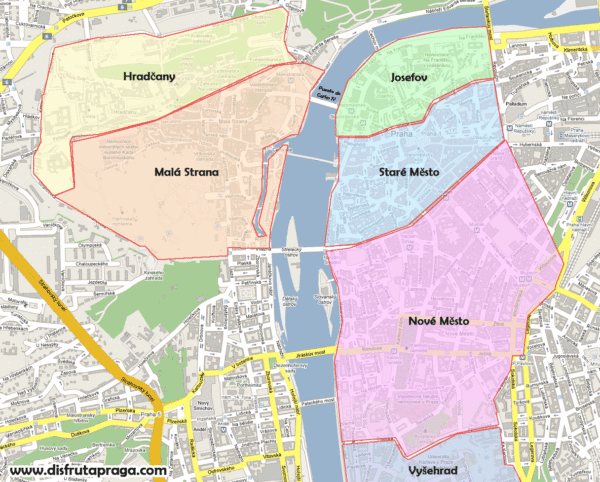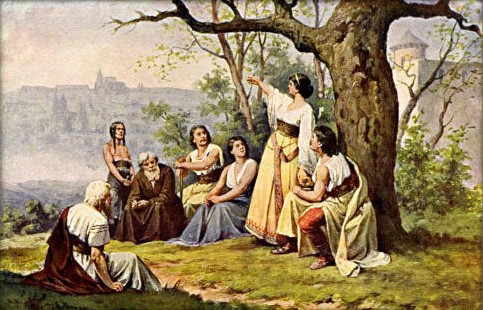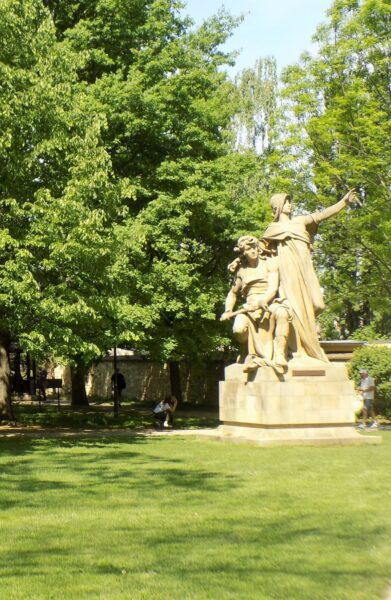Prague before Prague
The oldest know human artifact in today’s Czechia was discovered in the Pod hradem cave near the city of Brno some 200 kilometers southeast of Prague and dates to between 48,000 and 40,000 years BP. But despite my fascination with archaeology, I’m not going to drag you back that far. (If you’re interested in doing a little digging of your own, a good place to start might be this article from Science News or by looking into the ancient Únětice culture that occupied the area and dates from the late Paleolithic Age to the early Bronze Age. This culture is important because there are more than 1,400 documented Únětice sites in Czechia and Slovakia and the town that gives them their name is a mere 12km northeast of our hotel in Prague.)
As for me, I’ll start in 623 CE, when the Slavs adopted a Frankish merchant name Samo as their ruler because he’d helped them oust their erstwhile allies the Avars. In 631, Samo successfully defended this territory against the Franks in the Battle of Wogastisburg. For reasons I haven’t explored, Samo’s realm fell apart after his death in 658 and it was with the arrival of Bořivoj from Levý Hradec that the foundations for the castle and city of Prague are laid in the late ninth century.

(Map of Bohemia – Wikimedia Commons – Public Domain)
(By the way, in the fifth century BCE, this area was occupied by a Celtic tribe called the Boii. The Romans called it Boiohaemum – Latin for the Land of Boii. From this we have today’s Bohemia.)
Get on the bus
With no disrespect intended to Shlomit or Jana, our Czech guide, the first part of our tour Saturday morning barely rose to the low expectations I had. Our group trundled onto our small bus at about 09:00 and the first hour or so was akin to the Hop on Hop Off tours available in most major cities with the exception that this one had no hopping off. If I’d had a pocket full of grapes, I could have turned the event into a drive-by fruiting. Jana pointed out sites such as the National Museum or the Charles Bridge as we rumbled past.
Don’t infer from my grumbling that this ride was uninformative. Jana provided a helpful historical overview of how Prague achieved its current configuration evolving from four individual cities – each with its own town square and each surrounded by defensive walls – into a single city though still with four distinct quarters – Hradčany (Castle Quarter), Malá Strana (Little Quarter), Staré Město (Old Town), Nové Město (New Town). Vyšehrad (Castle Hill), and Josefov (which is essentially the Jewish Quarter and is often considered part of the Staré Město) are more like distinct districts.

(From cdn.civitatis.com)
As noted above, Bořivoj , began building Prague Castle in the ninth century. This makes Hradčany the oldest of the four cities. Other nobles began constructing their palaces nearby and today, this district is where you’ll find the presidential office and many foreign embassies.
Sometime in the 11th century people from the Castle District moved across the Vltava River and began to settle in today’s Staré Město. By 1230 they had completed a series of fortifications intended to provide protection for the merchants – Romans, Germans, and Jews who had settled there. These disparate parts unified at the end of the 13th century into the Hlavní Město (Major Town) at that time one of the largest in Europe.
At the foot of the castle in 1257, we see the official settlement of the Malá Strana. Like the Old Town it was initially market centric but a devastating fire in the 1540s changed its character to one of Baroque gardens and palaces occupied by Czech and other European nobility. You’ll find many embassies here, too.
Adjacent to Staré Město is Nové Město (New Town). In 1348, King Charles IV

(Wikimedia Commons – Public Domain)
set up New Town around the Hay and Straw Market, the Livestock Market and the Horse Market that is now St. Wenceslaus Square. In doing so, he effectively tripled the size of the urban area that would unify into a city resembling today’s Prague in the early 19th century.
Still, I have to admit that I came away a little confused because there seemed to be a new part of Old Town and an old part of New Town. For example, I believe our hotel was in the new section of the Old Town.
No special trip required
I, for one, was delighted to learn that our first true stop of the morning would be at Vyšehrad. This castle and grounds have significant cultural and historical importance in Prague. It includes the Chapel of St. Martin –

built in 1100 and the only complete Romanesque building in the castle itself. (The castle’s construction likely dates to the mid tenth century.) Several churches were built within the castle walls and one, the Basilica of St. Peter and St. Paul has next to it the only surviving cemetery of the four that were known to be within the castle – all dating to the middle ages – and one of the three Prague cemeteries I most wanted to visit. Thus, the reason for my excitement.
Vyšehrad Cemetery is known not only for its beauty

but also because beginning in the middle of the 19th century it became the preferred burial place for many Czech luminaries. Interestingly enough, this was one of the places in the castle complex Jana planned to take us. (Given the breadth of sites to visit within the castle complex such as the underground casements that house some of the original Baroque statues from the Charles Bridge, I think time constraints likely governed this choice.) But back to Vyšehrad Castle.
From what I could determine, the name Vyšehrad is the name of the rock on the promontory overlooking the Vltava. As noted above, the first reliable documents citing a castle on this rock date to the mid tenth century and refer to the castle as Chrasten. But Vyšehrad is closely associated with a number of Czech legends and legends can make places interesting.
Here, one of those is the legend of Libuše who is said to be the ancestor not only of the Přemyslid dynasty but of the entire Czech people. Libuše was one of three daughters of another mythic Czech figure and ruler called Krok. Because Libuše was the wisest of his three children, Krok chose her to succeed him. The legend goes on to claim that, sometime in the eighth or ninth century while standing on a rocky cliff above the Vltava, Libuše made this prophecy, “I see a great city whose glory will touch the stars.”

(Painting by Joseph Mathauser – Wikimedia Commons – Public Domain)
The Přemyslid dynasty draws its name from the plowman Přemysl whom Libuše married after ascending to the throne. They had three sons Radobyl, Lidomir, and Nezamysl who not only continued the dynasty but began to expand the territory of the Přemyslids from a small area around Prague to perhaps as far as current day Wroclaw in Poland. The first historically documented Přemyslid duke was Bořivoj whom you met briefly above.
In another part of her legend, Libuše commanded her councilors to establish a city at the place where they found a man making the best of use of his teeth at midday. They set off and at midday found a man sawing a block of wood (using his saw’s teeth) when everyone else was eating. They asked him what he was making. He answered, “Práh,” meaning threshold. Libuše then named the city they founded Praha.
Inside the castle grounds, the area called the Ducal and Royal Acropolis has four statues by J.V. Myslbek that were originally on the Palacký Bridge depicting a number of Czech myths and legends.
There’s the statue of Záboj and Slavoj the brothers who, according to the manuscripts of Dvůr Králové and of Zelená Hora, led a rebellion against an invasion by Charlemagne’s German troops in a victorious battle in 805.
Another depicts Ctirad and Šárka from the Bohemian mythic tale of The Maidens’ War, an uprising of women against men after the death of Libuše and that first appeared in the Chronica Boëmorum of Cosmas of Prague, in the 12th century.
The third portrays the legendary bard Lumír who refused to sing a hymn for the winners of The Maidens’ War. The legend says he sang his last song to Vyšehrad then broke his instrument.
Finally, of course, there’s this one depicting Libuše and Přemysl.

Our next stop will be a bit more musical. Meanwhile, the rest of the photos from this part of the morning are here.